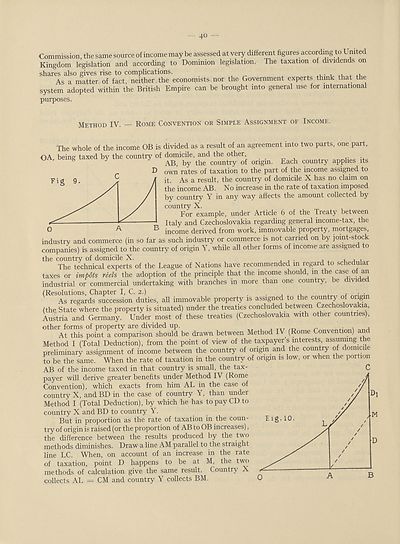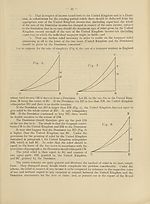Download files
Complete book:
Individual page:
Thumbnail gallery: Grid view | List view

4o -
Commission, the same source of income may be assessed at very different figures according to United
Kingdom legislation and according to Dominion legislation. The taxation of dividends on
shares also gives rise to complications. , . , ,,, ,,
As a matter of fact, neither the economists nor the Government experts think that the
system adopted within the British Empire can be brought into general use for international
purposes.
Method IV. Rome Convention or Simple Assignment of Income.
The whole of the income OB is divided as a result of an agreement into two parts, one part,
OA, being taxed by the country of domicile, and the other .. ..
S ^ ' AB, by the country of origin. Each country applies its
^ own rates of taxation to the part of the income assigned to
it. As a result, the country of domicile X has no claim on
the income AB. No increase in the rate of taxation imposed
by country Y in any way affects the amount collected by
country X.
For example, under Article 6 of the Treaty between
Italy and Czechoslovakia regarding general income-tax, the
income derived from work, immovable property, mortgages,
industry and commerce (in so far as such industry or commerce is not carried on by joint-stock
companies) is assigned to the country of origin Y, while all other forms of income are assigned to
the country of domicile X. j u j i ^
The technical experts of the League of Nations have recommended in regard to schedular
taxes or impots reels the adoption of the principle that the income should, in the case of an
industrial or commercial undertaking with branches in more than one country, be divi e
(Resolutions, Chapter I, C. 2.) . . , x , r ■ ■
As regards succession duties, all immovable property is assigned to the country of or g
(the State where the property is situated) under the treaties concluded between Czechoslovakia,
Austria and Germany. Under most of these treaties (Czechoslovakia with other countries),
other forms of property are divided up. r' ,• v „ j
At this point a comparison should be drawn between Method IV (Rome Convention) and
Method I (Total Deduction), from the point of view of the taxpayer’s interests, assuming t e
preliminary assignment of income between the country of origin and the country of domici e
to be the same. When the rate of taxation in the country of origin is low, or when the portion
AB of the income taxed in that country is small, the tax- C
payer will derive greater benefits under Method IV (Rome
Convention), which exacts from him AL in the case of
country X, and BD in the case of country Y, than under
Method I (Total Deduction), by which he has to pay CD to
country X and BD to country Y.
But in proportion as the rate of taxation in the coun¬
try of origin is raised (or the proportion of AB to OB increases),
the difference between the results produced by the two
methods diminishes. Draw a line AM parallel to the straight
line LC. When, on account of an increase in the rate
of taxation, point D happens to be at M, the two
methods of calculation give the same result. Country X
collects AL = CM and country Y collects BM.
Commission, the same source of income may be assessed at very different figures according to United
Kingdom legislation and according to Dominion legislation. The taxation of dividends on
shares also gives rise to complications. , . , ,,, ,,
As a matter of fact, neither the economists nor the Government experts think that the
system adopted within the British Empire can be brought into general use for international
purposes.
Method IV. Rome Convention or Simple Assignment of Income.
The whole of the income OB is divided as a result of an agreement into two parts, one part,
OA, being taxed by the country of domicile, and the other .. ..
S ^ ' AB, by the country of origin. Each country applies its
^ own rates of taxation to the part of the income assigned to
it. As a result, the country of domicile X has no claim on
the income AB. No increase in the rate of taxation imposed
by country Y in any way affects the amount collected by
country X.
For example, under Article 6 of the Treaty between
Italy and Czechoslovakia regarding general income-tax, the
income derived from work, immovable property, mortgages,
industry and commerce (in so far as such industry or commerce is not carried on by joint-stock
companies) is assigned to the country of origin Y, while all other forms of income are assigned to
the country of domicile X. j u j i ^
The technical experts of the League of Nations have recommended in regard to schedular
taxes or impots reels the adoption of the principle that the income should, in the case of an
industrial or commercial undertaking with branches in more than one country, be divi e
(Resolutions, Chapter I, C. 2.) . . , x , r ■ ■
As regards succession duties, all immovable property is assigned to the country of or g
(the State where the property is situated) under the treaties concluded between Czechoslovakia,
Austria and Germany. Under most of these treaties (Czechoslovakia with other countries),
other forms of property are divided up. r' ,• v „ j
At this point a comparison should be drawn between Method IV (Rome Convention) and
Method I (Total Deduction), from the point of view of the taxpayer’s interests, assuming t e
preliminary assignment of income between the country of origin and the country of domici e
to be the same. When the rate of taxation in the country of origin is low, or when the portion
AB of the income taxed in that country is small, the tax- C
payer will derive greater benefits under Method IV (Rome
Convention), which exacts from him AL in the case of
country X, and BD in the case of country Y, than under
Method I (Total Deduction), by which he has to pay CD to
country X and BD to country Y.
But in proportion as the rate of taxation in the coun¬
try of origin is raised (or the proportion of AB to OB increases),
the difference between the results produced by the two
methods diminishes. Draw a line AM parallel to the straight
line LC. When, on account of an increase in the rate
of taxation, point D happens to be at M, the two
methods of calculation give the same result. Country X
collects AL = CM and country Y collects BM.
Set display mode to:
![]() Universal Viewer |
Universal Viewer | ![]() Mirador |
Large image | Transcription
Mirador |
Large image | Transcription
Images and transcriptions on this page, including medium image downloads, may be used under the Creative Commons Attribution 4.0 International Licence unless otherwise stated. ![]()
| League of Nations > Economic and financial section > Double taxation and tax evasion > (46) |
|---|
| Permanent URL | https://digital.nls.uk/190911906 |
|---|
| Shelfmark | LN.II |
|---|
| Description | Over 1,200 documents from the non-political organs of the League of Nations that dealt with health, disarmament, economic and financial matters for the duration of the League (1919-1945). Also online are statistical bulletins, essential facts, and an overview of the League by the first Secretary General, Sir Eric Drummond. These items are part of the Official Publications collection at the National Library of Scotland. |
|---|---|
| Additional NLS resources: |
|

